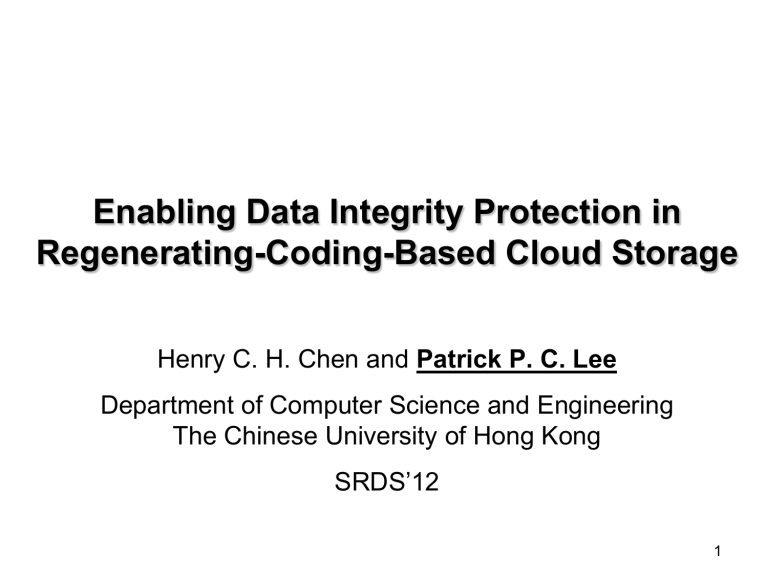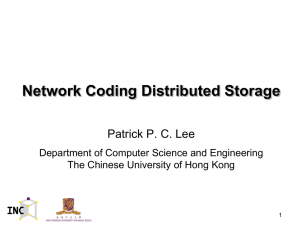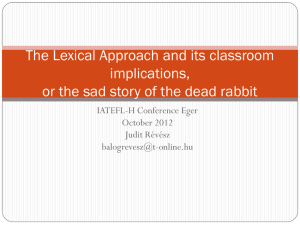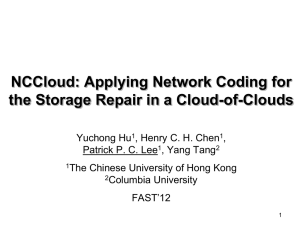talk - Department of Computer Science and Engineering

Enabling Data Integrity Protection in
Regenerating-Coding-Based Cloud Storage
Henry C. H. Chen and Patrick P. C. Lee
Department of Computer Science and Engineering
The Chinese University of Hong Kong
SRDS’12
1
Cloud Storage
Cloud storage is an emerging service model for remote backup and data synchronization
Is cloud storage fully reliable?
2
Problems in Cloud Storage
3
Cloud Storage Requirements
Data integrity protection
• Detect any corrupted data chunks stored on cloud servers
Fault tolerance
• Tolerate any cloud server failures
Efficient recovery
• Recover any lost/corrupted data chunks with minimal overhead
4
Related Work
Single server
• Provable Data Possession (PDP)
[Ateniese et al. ’07] and
Proof of Retrievability (POR)
[Juels et al. ’07]
• Verify data integrity by spot-checking a fraction of large files via cryptographic means
Multiple servers
• MR-PDP
[Curtmola et al. ’08]
• Target replication
• HAIL
[Bowers et al. ’09]
• Use erasure codes (e.g., Reed-Solomon codes) to provide less storage overhead than replication
5
Regenerating Codes
Regenerating codes
[Dimakis et al., 10] minimize repair traffic while maintaining same fault tolerance as erasure codes
• Implication: recover faster than erasure codes
Idea:
• Do not reconstruct the whole file as in erasure codes
• Instead, read only the chunks (smaller than whole file) that are needed to recover the lost chunks
• Build on network coding
NCCloud [Hu et al., ’12] provides an implementable design of regenerating codes
• Functional minimum storage regenerating (FMSR) codes
• Designed for long-term archival storage
6
Reed-Solomon Codes
Server 1 A
A
B
File of size M
Proxy
Reed Solomon codes
Repair traffic = M
Server 2 B
B
Server 3 A+B
A
A+B
Server 4 A+2B n = 4, k = 2
(n,k) MDS property: any k out of n servers can rebuild original file.
Conventional repair:
• Reconstruct whole file and generate data in new server
A
7
FMSR in NCCloud
[Hu et al., FAST’12]
Server 1
Server 2
Server 3
Server 4
P5
P6
P7
P8
P1
P2
P3
P4
A
B
C
D
File of size M
P3
P5
P7 n = 4, k = 2
Proxy
P1’
P2’
FMSR codes
Repair traffic = 0.75M
P1’
P2’
Code chunk P i
= linear combination of original native chunks
Repair in FMSR:
• Download one code chunk from each surviving server
• Reconstruct new code chunks via random linear combination
8
FMSR Property
Proxy
File partition k(n-k) chunks
A
B
C
D encode n(n-k) chunks
P1
P2
P3
P4
P5
P6
P7
P8 distribute
Servers (clouds)
P1
P2
P3
P4
P5
P6
P7
P8 n=4, k=2 c
1,1 c
1,2 c
1,3 c
1,4
.
.
.
A
B
C
D
P1
P2
P3
P4
P5
P6
P7
P8 c
8,1 c
8,2 c
8,3 c
8,4
Encoding matrix rank = k(n-k)
Native chunks Code chunks
9
FMSR Codes
FMSR codes
• Can achieve up to 50% repair traffic saving for general k = n-2 (i.e., RAID-6 tolerance)
• It is functional , i.e., fault tolerance is preserved
• It is suitable to long-term archival storage whose read frequency is rare
Can we enable integrity protection atop regenerating codes, while preserving repair traffic saving?
10
Our Contributions
Build a FMSR-DIP code, which enables data integrity protection , fault tolerance, and efficient recovery
Export tunable parameters from FMSR-DIP to trade performance and security
Implement and evaluate FMSR-DIP atop a real cloud storage testbed
11
FMSR-DIP Goals
Threat model: Byzantine, mobile adversary
[Bowers et al. ’09]
• exhibits arbitrary behavior
• corrupts different subsets of servers over time
Design goals:
• Preserve advantages of FMSR codes
• Work on thin clouds (i.e., only basic PUT/GET operations need to be supported)
• Support byte sampling to minimize cost
12
FMSR-DIP: Overview
Servers / clouds upload file
Users file download
NCCloud
FMSR code chunks
FMSR-
DIP
FMSR-DIP code chunks
Storage interface
Four operations: Upload, Check, Download and Repair
13
FMSR-DIP: Upload
8 FMSR code chunks, 3 bytes each
14
FMSR-DIP: Upload
Apply error-correcting code (ECC) to each chunk individually
15
FMSR-DIP: Upload
XOR each byte with a pseudorandom value
16
FMSR-DIP: Upload
For each chunk, calculate the MAC of the first 3 bytes
17
FMSR-DIP: Upload
Upload the chunks to clouds
Encrypt the metadata from NCCloud
(which contains the encoding matrix)
Append all MACs to metadata
Replicate metadata on all servers
18
FMSR-DIP: Check
Pick a row to check
19
FMSR-DIP: Check
XOR with the previous pseudorandom values, and check their consistency
20
FMSR-DIP: Check
Recall that from FMSR encoding: A x = P
• A = encoding matrix with rank = k(n-k)
• x = row of native chunks
• P = row of code chunks
P is a linear combination of x
Rank checking:
• Check if rank( A | P ) = rank( A ) = k(n-k)
21
FMSR-DIP: Download
Download chunks from any 2 servers and verify with their MACs
22
FMSR-DIP: Download
Remove pseudorandom values and pass to NCCloud for decoding
23
FMSR-DIP: Repair
24
FMSR-DIP: Repair
Download 1 chunk from all other servers and verify with their MACs
25
FMSR-DIP: Repair
Remove pseudorandom values and pass to NCCloud
26
FMSR-DIP: Repair
NCCloud generates new chunks
27
FMSR-DIP: Repair
Process the newly generated chunks as before
28
FMSR-DIP: Repair
Upload chunks and update metadata on all servers
29
FMSR-DIP Optimizations
By default, FMSR-DIP operates in units of bytes
FMSR-DIP can also operate in blocks
• A block is a sequence of bytes
• Better checking performance, but less security
We export different trade-off parameters that tune between performance and security
We conduct preliminary security analysis on
FMSR-DIP
See details in paper and technical report
30
FMSR-DIP: Experiments
Testbed environment
• Openstack Swift 1.4.2
• 1 proxy connected to storage servers over LAN
• NCCloud and FMSR-DIP deployed on proxy
• NCCloud uses RAMDisk as storage
Storage scheme
• (4,2)-FMSR
Goal: evaluate FMSR-DIP overhead over FMSR codes
31
20
0
Running Time vs. File Size
8
6
4
2
10
5
0
25
20
15
Transfer-Up
DIP-Encode
FMSR
100MB 50MB 20MB 10MB 5MB 1MB File size
Transfer-Down
DIP-Decode
FMSR
FMSR-DIP overhead comparable to network transfer time in a LAN environment
100MB 50MB 20MB 10MB 5MB 1MB File size
15
10
5
0
Transfer-Up
Transfer-Down
DIP-Encode
DIP-Decode
FMSR
100MB 50MB 20MB 10MB 5MB 1MB
File size
32
The Check Operation
80
70
60
50
40
30
20
10
0
1% check
Misc.
Transfer-Down
Rank Checking
PRF Bottleneck in network transfer
256B 1KB 4KB 7KB 25KB 256KB
Download block size
10
5
0
30
25
20
15
256KB download block size
100% 75% 50% 25% 10% 5% 1%
Misc.
Transfer-Down
Rank Checking
PRF
Checking percentage
33
Conclusions
Propose a design for efficient data integrity protection using FMSR on thin clouds
Implement and evaluate the efficiency of the design
Source code:
• http://ansrlab.cse.cuhk.edu.hk/software/fmsrdip/
34
Backup
35
Recall: FMSR Encoding
c
1,1 c
1,2 c
1,3 c
1,4 c
2,1 c
2,2 c
2,3 c
2,4 c
3,1 c
3,2 c
3,3 c
3,4 c
4,1 c
4,2 c
4,3 c
4,4 c
5,1 c
5,2 c
5,3 c
5,4 c
6,1 c
6,2 c
6,3 c
6,4 c
7,1 c
7,2 c
7,3 c
7,4 c
8,1 c
8,2 c
8,3 c
8,4
Encoding matrix rank = k(n-k)
A
B
C
D
Native chunks
P
3
P
4
P
1
P
2
P
5
P
6
P
7
P
8
Code chunks
36







